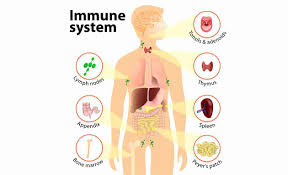Overview of the Immune System
The immune system is a complex and dynamic network of cells, tissues, and organs that collaborate to defend the body against pathogens and foreign substances. Its primary role is to identify, neutralize, and eliminate harmful agents, including bacteria, viruses, fungi, parasites, and even mutated cells that could lead to cancer. The immune system operates through a well-coordinated series of responses that can be categorized into two main types: innate immunity and adaptive immunity.

Components of the Immune System
- Primary Organs:
- Bone Marrow: The primary site for the production of immune cells. Hematopoietic stem cells in the bone marrow differentiate into various types of immune cells, including lymphocytes (B cells and T cells), monocytes, and granulocytes.
- Thymus: A specialized organ where T cells mature. The thymus is crucial for the development of the adaptive immune response, particularly for T lymphocytes which play vital roles in cellular immunity.
- Secondary Organs:
- Spleen: Acts as a filter for blood, removing old red blood cells and detecting pathogens. The spleen helps initiate immune responses by providing a site for lymphocyte activation and proliferation.
- Lymph Nodes: Small, bean-shaped structures that filter lymph fluid and serve as sites for immune cell activation. They contain a high concentration of B cells and T cells that respond to pathogens that have entered the lymphatic system.
- Cells of the Immune System:
- Lymphocytes:
- B Cells: Responsible for humoral immunity, producing antibodies that target specific antigens present on pathogens.
- T Cells: Involved in cell-mediated immunity. They can be further categorized into:
- Cytotoxic T Cells (CD8+ T Cells): Destroy infected or cancerous cells.
- Helper T Cells (CD4+ T Cells): Assist other immune cells, including B cells and macrophages.
- Phagocytes:
- Macrophages: Engulf and digest pathogens, presenting antigens to T cells to initiate adaptive responses.
- Neutrophils: The first responders to sites of infection, capable of phagocytosis and releasing enzymes to kill pathogens.
- Dendritic Cells: Act as antigen-presenting cells (APCs) that capture, process, and present antigens to T cells, playing a crucial role in bridging innate and adaptive immunity.
- Natural Killer (NK) Cells: Part of the innate immune system, these cells can recognize and destroy virus-infected or tumor cells without prior sensitization.
- Cytokines and Chemokines:
- Cytokines: Signaling proteins that facilitate communication between immune cells, regulating the intensity and duration of immune responses (e.g., interleukins, interferons, and tumor necrosis factor).
- Chemokines: A subset of cytokines that direct the migration of immune cells to sites of infection or inflammation.
Mechanisms of Immune Response
- Innate Immunity:
- This is the body’s first line of defense, providing an immediate but non-specific response to pathogens. It includes barriers such as the skin and mucous membranes, as well as immune cells and proteins. Innate immunity encompasses phagocytes, natural killer cells, and the complement system, which helps to opsonize pathogens and enhance phagocytosis.
- Adaptive Immunity:
- This immunity develops over time and involves a specific response to particular pathogens. It is characterized by the activation and proliferation of B and T lymphocytes following exposure to an antigen. Adaptive immunity generates immunological memory, allowing for a quicker and stronger response upon re-exposure to the same pathogen. Adaptive processes include:
- Humoral Response: Mediated by B cells that produce antibodies, which bind to antigens to neutralize pathogens directly or mark them for destruction by phagocytes.
- Cell-Mediated Response: Involves T cells that can directly kill infected cells or help orchestrate the overall immune response by activating other immune cells.
Immune Memory
The adaptive immune system has a unique capability known as immunological memory. After the initial exposure to a pathogen, some B and T cells become memory cells. These cells persist long after the infection has been cleared, allowing for a rapid and robust immune response if the pathogen is encountered again. This principle is the basis for vaccination, which aims to stimulate an immune response that confers long-term protection against specific diseases.
Regulation of the Immune System
The immune system is tightly regulated to ensure that it responds appropriately to infections while avoiding damage to the body’s own tissues. Several mechanisms prevent over-activity (autoimmunity) or underactivity (immunodeficiency):
- Checkpoint Inhibitors: Molecules that regulate T cell activation and prevent autoimmunity.
- Regulatory T Cells (Tregs): A subset of T cells that suppress immune responses and maintain tolerance to self-antigens.
- Cytokine Signaling: Various cytokines can upregulate or downregulate immune responses as needed.
Conclusion
The immune system is a remarkable and intricate network designed to protect the body from threats while maintaining balance and tolerance. Understanding its components and functions is crucial for advancing medical treatments and public health strategies, especially in the face of emerging infectious diseases and chronic immune-related conditions. Continuous research into the immune system not only aids in developing vaccines and therapies but also enhances our overall understanding of health and disease dynamics. As science progresses, the potential for harnessing the immune system for therapeutic purposes will dramatically influence modern medicine.
